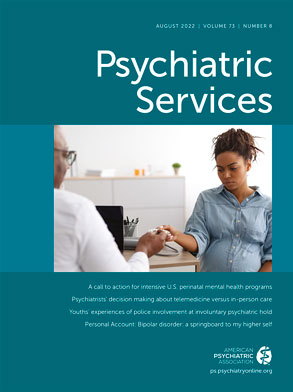Coordinated specialty care (CSC) is a community-based approach that leverages a multidisciplinary team to identify and treat patients who have early-onset psychosis (
1). Texas began CSC implementation in 2015 by using the OnTrackNY model (
2). By the summer of 2020, CSC programs were established within 24 public mental health providers across the state. CSC program implementation in Texas is unique because of the state’s size, geography, and racial-ethnic diversity, as well as widespread mental health workforce shortages and disparities in broadband and Internet access. No sites used widespread videoconferencing before the COVID-19 pandemic.
In response to the pandemic, and similar to other states (
3), Texas waived mental health service delivery regulations for telehealth and permitted Medicaid reimbursement for an extended range of services to ensure continuity of care (
4). Before the pandemic, Texas Medicaid reimbursed select virtual services, but reimbursements were largely limited to in-state physicians. Even though this emergency billing regulation allowed Texas CSC programs to provide virtual care to individuals experiencing psychosis, the emergency circumstances led to hurried implementation of telehealth practices without thorough analysis of provider technology needs, capacity, or resources.
The pandemic provided a natural opportunity to examine telehealth implementation across CSC sites. This report describes the barriers faced by CSC sites during the COVID-19 pandemic in sustaining CSC programs and how these barriers led to novel technology-related enhancements that have implications for increasing accessibility if continued post–COVID-19.
Results
Twenty-three team leaders participated. CSC programs had operated for varying durations (i.e., two began in 2015, eight in 2017, and 13 in 2019). Six sites (26%) served urban communities, 13 (57%) served rural communities, and the remaining four (17%) served multiple counties with varying population densities. The number of counties each site served varied, ranging from one to >20 counties. See
Table 1 for additional details.
The most common CSC implementation barrier during the pandemic was the inability of sites to provide various services virtually. Nine sites (39%) reported a limited capacity to deliver community-based outreach, family engagement, and vocational support. Pandemic-related organizational closures decreased hours of operation, and social distancing mandates decreased staff opportunity to connect clients to vocational opportunities. These challenges were especially salient for new sites that had just begun to establish their presence in the community. A team leader of a new rural site (site 23; see
Table 1 for site descriptions) noted the following:
“The issue with the COVID-19 [pandemic is that] we can’t do as much outreach as we wanted to. We had this grand plan right before all this happened to get out there and really just get outreach into the community and gather as many referrals and clients as we could, but that never happened. And that’s—it’s kind of making things go slower.”
To address these barriers, most sites (N=22, 96%) integrated videoconferencing technologies (i.e., Microsoft Teams, GoToMeeting, and Lifesize) into their operations and practices. Videoconferencing sustained CSC outreach and education, screening and assessment, service delivery (i.e., counseling, care coordination, psychoeducation, and prescribing) to clients and families, team collaboration, and staff professional development. With the addition of virtual technology, CSC sites could better tailor and coordinate care and strategically involve social supports according to client preferences and needs. Fourteen sites (61%) used text messaging before the pandemic and increased use of this technology during the pandemic. No patterns emerged as to which agencies allowed texting and which did not, and this variability appeared to be based on leadership preference. A new rural team leader (at site 3) stated, “I kept hearing that there were other agencies texting . . ., but we were discouraged from doing that. And so, it was a little frustrating.” However, other sites discussed texting as an important element of the program: “We are really comfortable texting our consumers. So, with their consent, we use a lot of texts, and with youth[s] it’s just so much easier to get a hold of somebody versus calling them” (team leader at site 9).
Some sites reported that before the pandemic, only psychiatrists provided virtual services; however, in light of the pandemic, most sites (N=21, 91%) expanded video-based services to all CSC team members (i.e., clinician and supported employment and education specialist). The team leader of a well-established urban site (site 14) said,
“[Coordinated virtual meetings with clients] allow the patient to get to know more than one staff or engage with more than one staff, or [to] have to answer [only] one GoToMeeting call versus five. . . . That’s what’s working well for us . . . we are communicating better as a team, which makes us communicate better with our patients.”
Another theme was the impact of reimbursement expansion for videoconferencing and phone calls’ providing greater flexibility to staff to engage a larger number of clients throughout their day. For example, a team leader of a new rural site (site 15) reported,
“Absolutely, and I think that's definitely evident in regards to COVID. Because of COVID, we've been providing services via telehealth. We've been providing phone services or videoconference services, and with that we’re able to fit more individuals into our schedule. We’ve noticed an increase in productivity compared to when we have to drive, because [for] some of the places, it takes like 45 minutes or so to get there. That definitely makes it harder for us to meet several individuals in a day.”
Additionally, staff leveraged virtual tools to promote learning. For example, three sites (13%) shared resources with clients through technology, such as e-mailing clinical worksheets (i.e., illness management and recovery), sharing mobile apps (i.e., Headspace), and sharing other wellness resources (i.e., OnTrackNY videos). Two sites (9%) shifted to virtual community partner outreach activities and client social groups. A team leader at an urban site (site 10) reflected, “Right now technology is our best friend, [and] we’re using it for everything.” Thirteen sites (57%) reported that virtual service integration promoted CSC engagement. In particular, six of 14 rural sites valued the use of technology to reach clients more efficiently and effectively. A team leader of a new rural site (site 6) said,
“Now we’re using GoToMeeting for the client side of it to engage anytime we can’t do face-to-face counseling and stuff like that. More as an engagement activity, [clients] would use Zoom to do game nights where they would play Jeopardy or something over Zoom and just have [many clients] on.”
All sites increased use of multiple technologies for team communication, which strengthened team connection and coordination through more frequent, real-time information sharing. Three sites (13%) highlighted the benefits of using the early days of the pandemic to complete virtual training and professional development opportunities, with eight sites (35%) noting expanded access to national training sessions via virtual delivery.
Despite the integration of new technologies, 48% (N=11) of sites reported barriers, including limited experience of a site with virtual service delivery and limitations of client technology access and connectivity. Sites serving rural catchment areas described frequently encountering issues with limited Internet access and poor connection, which strained communication with clients. Although sites reported that texting and virtual services improved some clients’ engagement, for others, it led to disengagement. Some clients frequently did not show for or were distracted during virtual appointments, did not respond to staff’s texts, and expressed a preference for in-person services. A team leader of a new rural site (site 15) said,
“[Clients are] all just tired and exhausted and like, ‘We just want to see you guys face to face. We're kind of [tired of speaking only on] the phone.’ And I've kind of noticed that in regards to just their level of engagement, where [for] some of the individuals, it seems like they're not as engaged anymore as prior to us providing services over the phone.”
Many sites lacked clear policies and practices to guide text and video interactions between CSC staff and clients. Although no sites reported having a videoconferencing policy in place (instead they followed state guidance), 11 (48%) had a text-messaging policy in place. Without these guiding policies, staff were concerned about security of certain videoconferencing platforms (i.e., Zoom and FaceTime) and were unclear about appropriate purposes (i.e., well-being checks vs. appointment reminders) for texting clients.
Discussion
Research emerging before the pandemic suggested the feasibility and positive impact of offering multiple modes of service delivery to increase engagement among individuals with serious mental health needs (
7). Although the pandemic created implementation barriers for Texas CSC sites, it spurred the integration of virtual technologies that appeared to sustain programs and expand methods to engage clients. With adequate financial resources, training, and policy guidance, CSC virtual technology can be sustained.
Our findings suggest that CSC clients and staff benefited from virtual technology integration. Specifically, technology facilitated more tailored communication with clients, likely increasing CSC participation. Providing services virtually allowed CSC staff to fit more clients into their daily schedules and allowed clients to meet with multiple providers simultaneously. Technology facilitated the sharing of CSC program resources among providers and clients. Technology also increased access to professional development opportunities for CSC staff and strengthened team communication.
Additional investigation is needed regarding the utility of virtual service delivery across team roles for engaging families and clients at varying stages of treatment engagement and recovery. Virtual CSC services may increase equity in access, especially for sites that serve individuals with transportation and general medical health challenges, in rural areas, and in large catchment areas. Despite the benefits of virtual technology, it was not utilized universally among sites. Many sites lacked training, resources, policies, and procedures for this technology. Both CSC staff and clients experienced exhaustion with using virtual technology. As CSC teams transition back to in-person services, significant opportunity exists to examine how sites strategically blend in-person with virtual services to promote client engagement, as well as staff wellness and productivity.
Limitations of this study included that it did not specifically seek to understand CSC site technology use during the pandemic but rather focused on understanding CSC operations and practices from the perspective of CSC team leaders. Additionally, most sites (N=13, 57%) were new, which may have skewed results in analyses.

